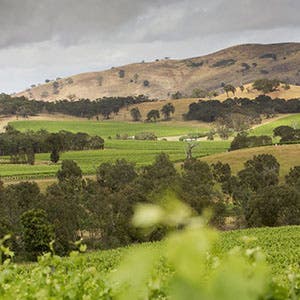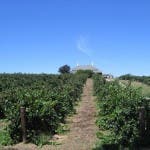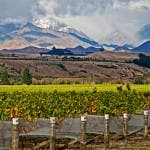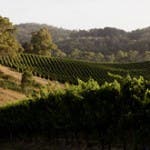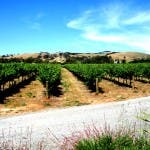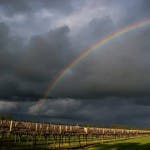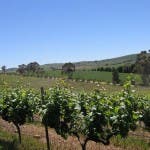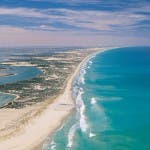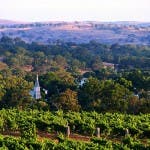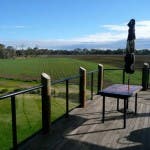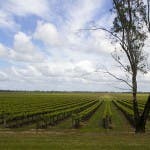regions
- Read moreFor most people, hearing the words 'the Pyrenees' makes their eyes glaze over and look distantly off to the left as they imagine the wonderful joys of Southern France, where it meets the Spanish border. Respond with the statement 'No, I meant the Pyrenees region of Victoria..' and their eyes revert back to the present moment and a quizzical look appears on their faces.. 'There's a Pyrenees in Australia?!' Yes, there most certainly is. Sir Thomas Livingstone Mitchell, Scottish surveyor and explorer first came upon this land in the year 1836. He was the first European on record to have travelled through this part of Victoria finding it more temperate in climate and better watered than NSW. This section of the Great Dividing Range reminded him of the Pyrenees in France, where he had previously served in battle. The first vineyards were planted here by the Mackareth family in 1848. The winery was said to be quite substantial, however around the end of the First World War, two brothers
- Read more
Most notable for being the first major wine region in Australia, the Hunter Valley had vines planted as early as 1789. The authorities at the time encouraged wine production, thinking that folks overindulging wine was preferable to filling up on strong spirits. Responsible Drinking back in the 1700's!
History of Hunter Valley
It was James Busby, after snapping up a chunk of the valley between Branxton and Singleton, who ushered in the region's (and in large part Australia's) presence on the world stage as a notable producer of acclaimed wines. Busby travelled throughout Europe and South Africa in 1831 collecting cuttings from over 500 vineyards, including Syrah from Hermitage in the Rhône. Many of these were planted in the Hunter, and notables like George Wyndham (Wyndham Estate) used cuttings from Busby's Kirkton vineyards. By 1876 there were approximately 1800 vines in the Hunter, and vineyards were growing
- Read more
Just 60km northeast of Adelaide, the Barossa Valley is one of Australia's oldest wine regions. Warm and dry, it is renowned for producing the distinctive Barossa Shiraz, a full-bodied red with notes of chocolate and spice. The valleys and sloping hills create several temperature ranges. But in summer, take it from us: it's just plain hot.
The soils range from clay and loam in the cooler areas to the classically South Australian sand and red-brown loam in the valleys. Irrigation is often required, but with water supply an increasing problem, many growers are practicing dryland farming, relying on what falls from the sky and clings from night fog. Couple this with the number of very old vines in the region (which produce limited quantities of grapes), and the result is fruit with deeply concentrated flavour which quickly ripen. A great foundation for some of the world's most acclaimed reds.
History
- Read more
Generally regarded as the launch point for the modern NZ wine world, Marlborough is as stunning to see as it is hospitable for growing Sauvignon Blanc. Cool, sea-lashed nights and warm days create long ripening seasons, giving NZ savvy's a fresh, green and intense flavour with wonderfully balanced acid. Drink them young, and enjoy them with seafood.
History
While wine has been produced in this region for decades (yeah, we hate to think that the 70's were THAT long ago), the 1980's were the watermark for Marlborough. The Sauvignon Blanc's were gaining attention for being as good, if not better, than anywhere else. This was aided by a gradual decline in making the wine with a smokey, oaked style. Clean and crisp with limed acid became the fashion, and critics showered them with praise. By the late 90's, many were writing that Marlborough was the best spot on earth to grow Sauvignon Blanc.
Visiting
Today, the demand and quality have made Marlborough the
- Read more
Considerably cooler than the surrounding plains, the hills are washed in rain during winter months, and the peaks wrapped in fog. It is considered a high rainfall region compared to other Australian regions, but outside of winter the climate is warm and dry. Night time temperatures are the feature - notably cooler than the day when the sun sets. Worth noting is how the average rainfall increases the higher you go, with Mount Lofty picking up 1400mm on the old splash-o-meter compared to 850mm just 10K down the road in Charleston. This range of moisture and altitudes results in a variety of soils, but in general are sand and clay loam over clay subsoils. A bit of shale and ironstone can be found, and the soil is acidic on average and rarely acidic.
The combination of climate and soil lends to superb cool-weather whites like Riesling (if you watch for mould), Sauvignon Blanc, Pinot Noir and crisp Chardonnays. Merlot, Shiraz, Cabernet Sauvignon can also be found, with the grapes maturing
- Read more
Less than 40km south of Adelaide, McLaren Vale is another one of South Australia's renowned Shiraz producers, accounting for roughly 50% of grapes crushed annually. The climate is markedly different from the Barossa, being much more Mediterranean with four clear seasons and higher rainfalls. McLaren Vale reds reflect this, showing deep complexity and power along with the ability to cellar for decades. While Shiraz grabs the most attention, chocolate-rich Cabernet Sauvignons, Chardonnays and Viogniers are worth sampling.
The climate is influenced by ocean breezes coming in from the Gulf of St. Vincent to the west and the altitude of the Sellicks Hill Range to the south. Soil type is varied, ranging from red-brown loam and sand to dark clay and the often-mentioned terra rosa. A misspell of the Italian phrase "terra rossa" (meaning "red soil"), this ruddy-red stuff is left behind when limestone breaks down, and any viticulturist will tell you it's great stuff to grow vines in due
- Read more
If there is one combination to look for when browsing for a good medium-bodied red, Coonawarra, terra rosa and Cabernet Sauvignon is always a winner. Far down the line from Adelaide (about 390km southeast, a grape's throw from the border of Victoria), the name is Aboriginal for "honeysuckle", yet reds from the region are more known for flavours of plum and blackcurrant.
The Coonawarra vineyard region is sparse, running along a thin 2km-wide ridge elevating it above surrounding swamp. World-renowned, this 15km stretch of red soil is so unique, it's worth looking it up on google maps and switching to satellite view to see how it is farmed. See that strip of green north of Penola? That's it, and notice the big spread of nothing around it? The Coonawarra is a very special place. Laying on an old ridge of limestone, the fields have superb drainage, allowing the vines to flourish without the dampness at night that can ruin a good crop. Very similar in climate to the Bordeaux region in
- Read more
130km north of Adelaide (and west of the Barossa), the Clare Valley sits within a high-altitude pocket granting the vineyards cool to cold nights with long, warm to hot summer days. This cooler climate grants thin-skinned (and indeed temperamental) grapes like rieslings a perfect climate in which to mature slowly without risk of mould during the harvest season. The resulting wines are perfumed, complex, softly flavoured yet powerful.
There are several sub-regions in the 35km stretch of valley, pocketed with varying soils, altitudes and climates. West-facing, high-altitude slopes benefit from drying afternoon sun in summer, producing some of the regions best vintages. The vines are planted from 400 to 500 metres (1,300 to 1,600 ft). The higher altitude, compared to other wine regions in South Australia, ensures cool nights even during the heat of summer allowing the fruit to ripen more evenly and slowly. Soil is a mix of red to brown-grey over basement rock.
History
- Read more
The Limestone Cost comprises a few sub-regions you've likely already heard of, such as the acclaimed Coonawarra. But in amongst the known are some hardly knowns that you may miss, and shouldn't.
Wrattonbully, Mount Benson and Padthaway – feel free to read up on these in more detail, but here's an overview.
History
With vines dating back to the 1970's, Wrattonbully grew to fame in the early 90's when larger producers like Hardy's and Beringer Blass began planting. Primarily a red region, with shiraz and cabernet sauvignon in quantity.
Mount Benson, first planted in 1989, is a newcomer to the South Australian industry. It has quickly established itself as on par with it's older cousins, producing excellent cabernet sauvignon, shiraz, and chardonnay. Cool ocean breezes aid in producing complex, deeply flavoured wines.
Padthaway, like the Coonawarra, has the same red-gold soil, but warmer temperatures overall. Similar in climate to the
- Read moreAdjacent to the eastern edge of the Barossa Valley, Eden Valley is not actually a valley. Allegedly, early settlers found the word "Eden" scratched into a tree and named the town Eden Valley. What we do know is that it produces fantastic riesling and chardonnay, having a cooler, higher-altitude climate than the Barossa. Reds of great merit come from here as well, with producers like Henschke dazzling tasters worldwide. Soil is dry and sandy, laying across windswept hills. A bit of a challenge for growers, with vineyards scattered throughout the region to take advantage of winter rainfall and the cooler temperatures. Altitude is 400-600 metres above sea level, providing cool nights and long warm days for growing season. Perfect for thin-skinned whites like rieslings, which benefit from lots of sunshine and cooler nights, but are susceptible to mould if the ground is damp at harvest time.
History
The township was founded in 1864 by William Lillecrapp (no snickering back there!). - Read more
Around 50km southeast of Adelaide, and just north of Lake Alexandrina, Langhorne Creek is one of the oldest vineyard regions in South Australia. With vines first planted in 1860's, it is predominately a producer of full-bodied reds. Cabernet sauvignon and shiraz do well in the cool climate, and benefit from the unique soils along the riverbanks.
The climate is often cool, with southerly winds coming in from the ocean and blowing straight across Lake Alexandrina. Like most South Australian regions, the heat will kick in when the wind comes down from the north in summer, but there are intermittent and not as constant as they are up north in the Barossa. Soils are deep, sandy loams, regularly flooded in winter by diverting the nearby Bremer River into the vineyards. This all adds up to vigorous vines with generous canopies,
- Read more
A part of the Limestone Coast region, Padthaway is about a half-days drive southeast from Adelaide, just a tick from the Victorian border. Chardonnay thrives here, with notable production of pinot noir, cabernet sauvignon and shiraz adding to the total annual crush.
History
The area sits on terra rosa soil, with good drainage into a limestone base. Quite swampy in spots (it was nicknamed "Mosquito Plains" in the mid-1800s), the area has good bore water supply, which led to the CSIRO recommending the area for horticultural development in 1944 (it was primarily a livestock farming area back then). But with the Australian wine industry in a ditch in the 40's, decades passed before vines were planted by Seppelts in 1964.
Close enough to the coast to benefit from southerlies coming off the ocean, Padthaway is further north than cousin Coonawarra, and does run a bit hotter being down on the plains. Big producers have vineyards here, such as Hardys, Blass, and Orlando

